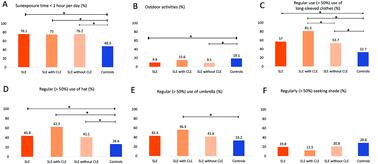当前位置:
X-MOL 学术
›
Photochem. Photobiol. Sci.
›
论文详情
Our official English website, www.x-mol.net, welcomes your feedback! (Note: you will need to create a separate account there.)
The behavior, attitude, and knowledge towards photoprotection in patients with cutaneous/systemic lupus erythematosus: a comparative study with 526 patients and healthy controls.
Photochemical & Photobiological Sciences ( IF 3.1 ) Pub Date : 2020-07-13 , DOI: 10.1039/d0pp00073f Kumutnart Chanprapaph 1 , Monthanat Ploydaeng 1 , Kallapan Pakornphadungsit 1 , Thiraphong Mekwilaiphan 1 , Vasanop Vachiramon 1 , Silada Kanokrungsee 1, 2
Photochemical & Photobiological Sciences ( IF 3.1 ) Pub Date : 2020-07-13 , DOI: 10.1039/d0pp00073f Kumutnart Chanprapaph 1 , Monthanat Ploydaeng 1 , Kallapan Pakornphadungsit 1 , Thiraphong Mekwilaiphan 1 , Vasanop Vachiramon 1 , Silada Kanokrungsee 1, 2
Affiliation

|
Objective: To evaluate the attitude, knowledge, and behavior towards the sun protection in systemic lupus erythematosus (SLE) patients with and without cutaneous involvement (CLE) compared to non-photosensitive controls and to determine influential factors for photoprotective practices in SLE patients. Methods: A case-control study was performed. Patients and controls completed a self-reported questionnaire. For SLE patients, the presence of organ involvement, disease activity and laboratory data were acquired from their physical examination and medical records. Results: A total of 263 SLE patients and 263 healthy controls were recruited. SLE patients had statistically significant better photoprotective practices than controls, i.e. exposure to sunlight <1 hour per day (76.1% vs. 48.3%, OR, 3.40; 95% CI, 2.34–4.93, p < 0.001), less outdoor activities (9.8% vs. 19.1%, OR, 0.44; 95% CI, 0.26–0.71, p = 0.003), wore long-sleeved shirts (57.0% vs. 32.7%, OR, 2.73; 95% CI, 1.92–3.89, p < 0.001) and hats (43.8% vs. 26.6%, OR 2.14; 95% CI, 1.49–3.09, p < 0.001). SLE with CLE subgroup had the highest percentage for regular practice in almost all sun protective means compared to SLE without CLE and controls. SLE with CLE patients had more diligent sunscreen application with higher percentage of consistent use (93.7% vs. 59.3%, OR, 11.66; 95% CI, 2.57–52.89, p = 0.001) and adequate application (58.1% vs. 24.6%, OR, 4.24; 95% CI, 1.93–9.30, p < 0.001) compared to those without CLE. Previous and current CLE were influential factors for adherence to photoprotective methods, while the extracutaneous involvement was not. The majority of SLE patients were well acquainted with the harm of sunlight to their diseases (91.6%). However, 40.1% of them did not perceive that sunlight could escalate their internal flare, which may have led to inferior photoprotective practices in patients with extracutaneous involvement. Conclusion: SLE patients had good awareness and practiced better photoprotection than controls. The cutaneous sign is a predictor for superior photoprotective behavior. Education regarding the harms of sunlight and the importance of appropriate photoprotection should be emphasized, especially in SLE cases without cutaneous involvement.
中文翻译:

皮肤/系统性红斑狼疮患者的光保护行为,态度和知识:526名患者和健康对照者的比较研究。
目的:评估与非光敏性对照相比,有和没有皮肤受累(CLE)的系统性红斑狼疮(SLE)患者对防晒的态度,知识和行为,并确定影响SLE患者光保护措施的因素。方法:进行病例对照研究。患者和对照者填写了一份自我报告的问卷。对于SLE患者,从他们的身体检查和医疗记录中获取器官参与,疾病活动和实验室数据的存在。结果:总共招募了263名SLE患者和263名健康对照者。SLE患者的光保护措施在统计学上比对照组更好,即每天暴露于阳光下少于1小时(76.1%vs. 48.3%,OR,3.40; 95%CI,2.34–4.93,p <0.001),较少的户外活动(9.8%vs . 19.1%,OR,0.44; 95% CI,0.26-0.71,p = 0.003),穿长袖衬衫(57.0%比32.7%,OR,2.73; 95%CI,1.92-3.89,p <0.001)和帽子(43.8%比26.6%,或2.14; 95%CI,1.49–3.09,p <0.001)。与没有CLE和对照组的SLE相比,具有CLE亚组的SLE在几乎所有防晒措施中的常规练习百分比最高。SLE合并CLE的患者应更加勤奋地使用防晒霜,并持续使用的百分比更高(93.7%vs。59.3%,或11.66; 与没有CLE的患者相比,CI为95%的患者,为2.57–52.89,p = 0.001)(58.1%vs . 24.6%,OR,为4.24; 95%CI,为1.93–9.30,p <0.001)。先前和当前的CLE是坚持光保护方法的影响因素,而皮肤外侵犯则不是。大多数SLE患者都非常了解阳光对其疾病的危害(91.6%)。但是,其中40.1%的人没有意识到阳光会加剧其内部耀斑,这可能导致皮下侵犯患者的光保护措施较差。结论:SLE患者具有良好的意识,并且比对照组具有更好的光保护作用。皮肤征兆是优越的光保护行为的预测指标。应该强调有关阳光的危害以及适当的光保护的重要性的教育,尤其是在没有皮肤受累的SLE病例中。
更新日期:2020-09-16
中文翻译:

皮肤/系统性红斑狼疮患者的光保护行为,态度和知识:526名患者和健康对照者的比较研究。
目的:评估与非光敏性对照相比,有和没有皮肤受累(CLE)的系统性红斑狼疮(SLE)患者对防晒的态度,知识和行为,并确定影响SLE患者光保护措施的因素。方法:进行病例对照研究。患者和对照者填写了一份自我报告的问卷。对于SLE患者,从他们的身体检查和医疗记录中获取器官参与,疾病活动和实验室数据的存在。结果:总共招募了263名SLE患者和263名健康对照者。SLE患者的光保护措施在统计学上比对照组更好,即每天暴露于阳光下少于1小时(76.1%vs. 48.3%,OR,3.40; 95%CI,2.34–4.93,p <0.001),较少的户外活动(9.8%vs . 19.1%,OR,0.44; 95% CI,0.26-0.71,p = 0.003),穿长袖衬衫(57.0%比32.7%,OR,2.73; 95%CI,1.92-3.89,p <0.001)和帽子(43.8%比26.6%,或2.14; 95%CI,1.49–3.09,p <0.001)。与没有CLE和对照组的SLE相比,具有CLE亚组的SLE在几乎所有防晒措施中的常规练习百分比最高。SLE合并CLE的患者应更加勤奋地使用防晒霜,并持续使用的百分比更高(93.7%vs。59.3%,或11.66; 与没有CLE的患者相比,CI为95%的患者,为2.57–52.89,p = 0.001)(58.1%vs . 24.6%,OR,为4.24; 95%CI,为1.93–9.30,p <0.001)。先前和当前的CLE是坚持光保护方法的影响因素,而皮肤外侵犯则不是。大多数SLE患者都非常了解阳光对其疾病的危害(91.6%)。但是,其中40.1%的人没有意识到阳光会加剧其内部耀斑,这可能导致皮下侵犯患者的光保护措施较差。结论:SLE患者具有良好的意识,并且比对照组具有更好的光保护作用。皮肤征兆是优越的光保护行为的预测指标。应该强调有关阳光的危害以及适当的光保护的重要性的教育,尤其是在没有皮肤受累的SLE病例中。



























 京公网安备 11010802027423号
京公网安备 11010802027423号